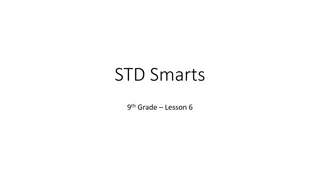UI Demo & Best Practices - July 9th, 2015
This content showcases a comprehensive demonstration and best practices session covering topics such as virtualized RAID, traditional RAID, licensing for RealStor 2.0, and GUI demonstrations. The materials delve into differences between QXS and Dot Hill, outlining the nuances of various RAID setups and storage solutions. Licensing details, including features like tiering, thin provisioning, and rapid rebuild, are explained. The best practices emphasize the importance of balancing virtual volumes for optimal performance.
Uploaded on Mar 18, 2025 | 0 Views
Download Presentation

Please find below an Image/Link to download the presentation.
The content on the website is provided AS IS for your information and personal use only. It may not be sold, licensed, or shared on other websites without obtaining consent from the author.If you encounter any issues during the download, it is possible that the publisher has removed the file from their server.
You are allowed to download the files provided on this website for personal or commercial use, subject to the condition that they are used lawfully. All files are the property of their respective owners.
The content on the website is provided AS IS for your information and personal use only. It may not be sold, licensed, or shared on other websites without obtaining consent from the author.
E N D
Presentation Transcript
UI Demo & Best Practices July 9th, 2015
Agenda Product Demonstration Install licenses Virtualized RAID Overview Creating LUNS Mapping Hosts Traditional RAID (short review) IO demonstration Configuring Users Configuring Email/SNMP One-off Tasks Rebooting Firmware Updates Logs Best Practices Q/A | 2 Quantum Confidential
QXS & Dot Hill differences | 3 Quantum Confidential
Traditional RAID (Linear) RAID Sets Disks Linear LUNs RAID1 LUN SSD SSD Pool RAID10 LUN 10K 10K LUN RAID6 LUN 7K 7K LUN LUN | 4 Quantum Confidential
Virtualized RAID Disks RAID Sets Pool Virtual LUNs RAID1 SSD SSD Pool RAID10 LUN LUN LUN 10K 10K LUN LUN LUN RAID6 7K 7K | 5 Quantum Confidential
Virtualized RAID RealStor 2.0 RealStor 2.0 Virtualized RAID Is: Virtualized Storage via Pools Using 4MB pages Distributed across multiple RAID sets Auto Tiering Quick Rebuild Space allocation on demand Advanced Copy Services Providing: Plus Algorithms that monitor I/O access patterns to automatically cache data or move it to optimal locations based on workload. Intelligence: | 6 Quantum Confidential
Licensing | 7 Quantum Confidential
Licensing for RealStor 2.0 Included in the box: Tiering for HDD s Thin Provisioning Rapid Rebuild Virtualized Snapshots SSD Read Cache Licensable Options Tiering for Flash Software support One year of software support is required with this feature Associated Hardware 4004 series arrays 3004 coming in Q3 6004 coming in Q4 | 8 Quantum Confidential
GUI Demonstration | | 9 9 Quantum Confidential Quantum Confidential
Best Practices Virtual Volumes- Balance | 10 Quantum Confidential
Balance across controllers Strive for a workload balanced across controllers/pools Unbalanced pools are more difficult to expand long-term, one controller could end up being a bottleneck after expansion | 11 Quantum Confidential
Balance Among disk groups Disk count balance RAID Balance Tier is as slow as the slowest disk group Strive for common rotational latencies in a tier (all 10K or all 15K) Pool A Pool B dgA01 RAID 1 dgB01 RAID 1 dgA02 RAID 5 dgA03 RAID 5 dgB02 RAID 5 dgB03 RAID 5 | 12 Quantum Confidential
Disk Group Count Write Queue-depth per disk group is 100 Latency sensitive, high IOPS applications could hit this queue depth Example 1: Same count, but less q-depth Example 2: Lower capacity, but higher q-depth dgB02 RAID 1 dgA01 RAID 10 dgB01 RAID 1 dgA02 RAID 5 dgB03 RAID 5 dgB04 RAID 5 | 13 Quantum Confidential
Balance disk groups across drawers (4U56) Each controller is limited to 4 lanes of SAS to each drawer. Limits throughput to 2.1 GB/sec into each drawer If you put an entire disk group in one drawer, then the single drawer becomes a bottleneck Best Practice: Spread disk groups across the drawers for maximum throughput | 14 Quantum Confidential
Best Practices Virtual Volumes & Parity Based RAID | 15 Quantum Confidential
Key Concept Reminder 4MB pages of data are building blocks Large impact to RAID5/RAID6 disk groups RAID5/RAID 6 use 512K chunk size if the # of data disk is a power of 2 RAID5/RAID6 use a 64K chunk size if the # of data data disk is not a power of 2 Sequential workloads can be impacted by non-aligned writes Disks Disk Group Virtual LUNs Pool RAID1 Pool SSD SSD LUN LUN LUN LUN LUN RAID6 LUN 7K 7K | 16 Quantum Confidential
Unaligned Write example RAID5 (5+1): Stripe Unit=512K, Stripe size=2MB Disk 2 Disk 6 Disk 5 Disk 3 Disk 1 Disk 4 A5 A1 Bp Ap A2 B1 A3 B2 A4 B3 Stripe A Stripe B B5 B4 A single page doesn t align. The data from disk 5 and 6 must be read so that parity can be re- calculated. Extraneous writes for every page written 14 Disk I/Os + 1 XOR to write a single page 1 page written with 1 Full Stripe Writes, and 1 partial stripe write NOTE: The array will set the stripe unit to 64K to mitigate this issue | 17 Quantum Confidential
4MB page aligned writes RAID5 (4+1): Stripe Unit=512K, Stripe size=2MB Disk 2 Disk5 Disk 3 Disk 1 Disk 4 Ap A1 Bp A2 B1 A3 A4 Stripe A Stripe B B4 B2 B3 10 Disk IO s & 2 XOR calculations 1 pages written with 2 Full Stripe Writes the Holy Grail! | 18 Quantum Confidential
Best Practices Best Practices Others | 19 Quantum Confidential
VMWare When volumes are removed from an ESX host without properly un-mounting, then the ESX host will query the storage system for the LUN The array returns Not Ready ; ESX keeps trying! This will slow down the host Use the following CLI command: # set advanced-settings missing-lun-response illegal | 20 Quantum Confidential
Q/A | 21 Quantum Confidential
RAID5/6 & Virtual Volumes Partial-stripe writes severely degrade performance To keep performance high, data drives should be a power of 2: RAID6: 2 data drives + 2 for parity 4 data drives + 2 for parity 8 data drives + 2 for parity RAID5: 2 data drives + 1 for parity 4 data drives + 1 for parity 8 data drives + 1 for parity Consider linear volumes unless you want quicker rebuild | 22 Quantum Confidential
Automated Tiered Storage (RealTierTM) | 25 Quantum Confidential
Real-Time Tiering Real-Time analysis and data movement Continuous monitoring and adjustment Autonomic Runs automatically in the background without any user intervention Fine-grained data movement Sub-LUN tiering 4MB pages of data SSD Fast HDD Nearline HDD | 26 Quantum Confidential
Tiering What this means: Constant background scanning for hot data Hot pages are moved immediately no waiting Performance improvements can be seen almost immediately. Shows immediate performance gains with difficult (cache-unfriendly) workloads Optimized to move data up Excellent for Database & OLTP workloads Hot Data Cool Data Cold Data | 27 Quantum Confidential
Thin Provisioning (RealThinTM) | 28 Quantum Confidential
Thin Provisioning Enabled/Disabled for all volumes in a pool Disk space is used only when it is written to No space reservations are made at LUN creation time LUN size is independent of physical disk space Add capacity when needed Reclaim unused space T-10 Unmap Background space reclamation Pool Free space Used space | 29 Quantum Confidential May, 2014
Thin Provisioning Alerts sent at configurable capacity thresholds Low Threshold 25% of space consumed Mid Threshold 50% of space consumed High Threshold Calculated (approximately 90-95%) Not user configurable What happens when we run out of space? If we re overbooked and exceed the high threshold then we switch to write-through mode Lowers performance, but gives more time to add storage | 30 Quantum Confidential May, 2014
Rapid Rebuilds (RealQuickTM) | 31 Quantum Confidential
Quick Rebuild Disk 1 Disk 2 Disk 3 Affected stripes Rebuilt user data | 32 Quantum Confidential May, 2014
Quick Rebuild Advantages: LUNs are spread across many RAID sets. So one RAID set rebuilding only affects a fraction of all disk I/Os Less rebuild work to do so affected disks can return to full performance quickly. Volumes become fault tolerant more quickly user data is restored to full protection more quickly. Speedup is directly proportional to amount of unused disk space When is this important? When using large capacity drives 4TB/6TB/8TB drives When using parity-based RAID in disk groups (RAID5, RAID6) | 33 Quantum Confidential May, 2014
SSD Read Cache (RealCacheTM) | 34 Quantum Confidential
SSD Read Cache Improves performance of read-centric transactional workloads The SSD cache becomes an extension of the controller cache A lower cost way to get performance improvement from SSD Uses the number of SSDs as the SSD tier Holds a (volatile) copy of data Read cache SSD failure never causes data loss Provides improved performance in random, read-centric workloads Hints SSD Virtualized Backend I/O Mapping Controller Cache Copy Data I/O HDDs | 35 Quantum Confidential 11/14/2013
Virtualized Snapshots (RealSnapTM) | 36 Quantum Confidential
Virtualized Snapshot All volumes are equivalent: All volumes are snappable, including snapshots No loss of performance for snaps Opens new opportunities for using snaps (e.g. data mining, daily backups) High Performance Write Redirect uses less I/O operations than COW All volumes have the same high performance; even the 100th snap of a volume Leverages larger controller CPU memory Source Volume Snapshot Volume Take Snapshot Volume Volume Page Ref=1 Ref=2 Page Page Tables Page Tables Page Ref=1 Ref=2 Page Page Ref=1 Ref=2 Page | 37 Quantum Confidential May, 2014
Large LUNs | 38 Quantum Confidential
Large, Flexible Volumes Volume sizes up to 128TiB (140TB) Spanning up to 256 HDDs (architectural limit) Seamless capacity expansion Data automatically rebalances to newly added RAID sets IOPS & Throughput scale with additional storage Volumes can be expanded | 39 Quantum Confidential























